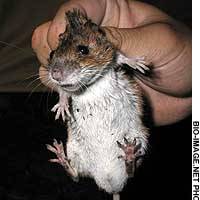* Japanese name: Aka nezumi
* Scientific name: Apodemus speciosus (large field mouse)
* Description: These mice are 9-14 cm long, with hazel-brown fur on top, and a white throat and belly. They have large black eyes, a well-developed sense of smell and sensitive whiskers. Females have eight nipples.
* Where to find them: Pretty much everywhere from grassy fields and farms to riversides and forests, from Hokkaido to Kyushu. They are nocturnal. During the day they live in their burrows.
* Food: Like all small mammals, field mice have very fast metabolisms and need to eat lots to survive. So they are not fussy eaters, taking insects as well as roots, grains, seeds, berries and nuts.
* Special features: Field mice are capable swimmers. Most individuals live their entire lives and die within 180 meters of their birthplace. They give birth to a litter of 1-8 young, up to six times a year. They are not confined to a breeding season and females can become pregnant at any time, like humans. A sister species, the small field mouse (Apodemus argenteus), lives in woodlands and has 2-12 young. In both species the males are more or less monogamous and help the female in raising the young. The small field mouse is said to be cuter (its name in Japanese, hime nezumi, means princess mouse). It spends at least half of its time in trees (collecting seeds and insects) and may even live in abandoned bird nests. Both species of field mice can harbor infectious diseases, such as Lyme disease. This is spread when ticks feed on the blood of the mice and become infected by the bacteria. A bite from an infected tick can pass Lyme disease to humans.
8 mins ago


















With your current subscription plan you can comment on stories. However, before writing your first comment, please create a display name in the Profile section of your subscriber account page.